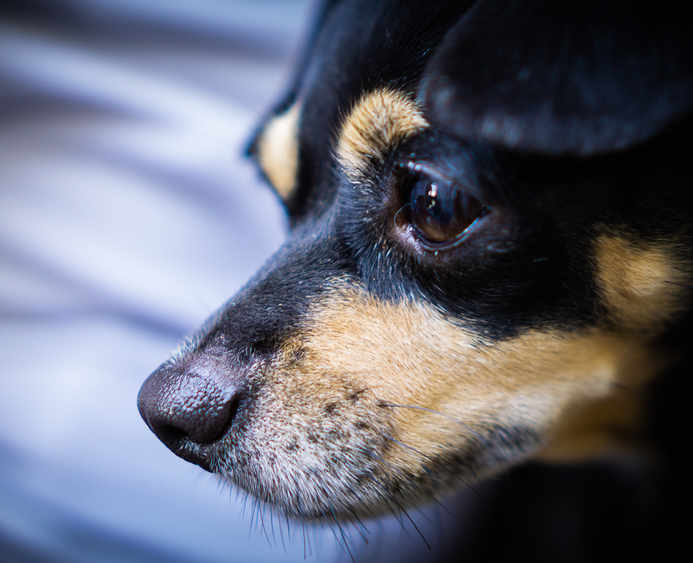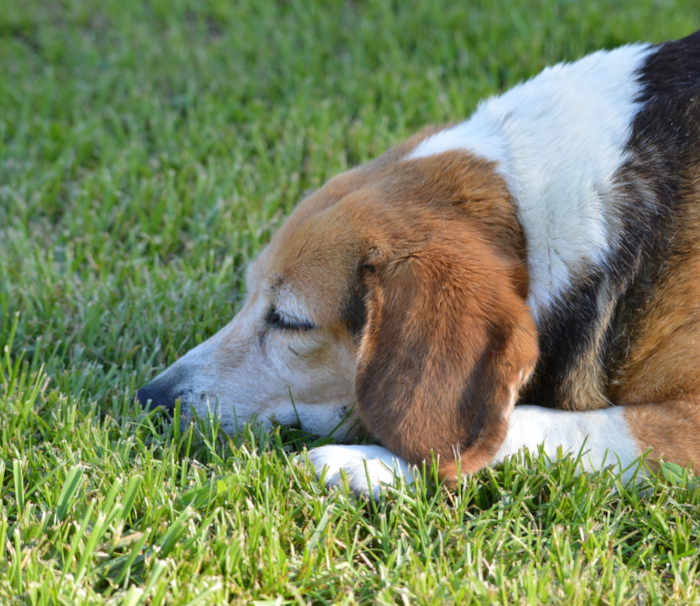
With canine patients who suffered from seizures, owners would ask why their pup acted differently after the convulsions. I would explain what types of behavior to expect in the recovery (post-ictal) period and what signs would be concerning.
In this article, we’ll talk about what happens during different phases of seizures in dogs, what to expect, and what would be a cause for concern. To help you respond to seizures in your pup, we’ll go over what to do during an episode. We’ll finish by discussing the long-term effects of convulsions and what you should do if your dog doesn’t recover from a seizure.
Do most dogs show different behaviors after a seizure?
Dogs usually have a post-ictal or recovery phase following a seizure. In most cases, as the brain regroups from the elevated activity, dogs will show altered behavior, including:
- Temporary blindness
- Confusion
- Disorientation
- Hypersalivation
- Pacing/restlessness
- Stumbling/incoordination
The post-ictal phase can last anywhere from a few minutes to several days.
How do dogs behave during the different stages of seizures in dogs?
Canine seizures usually occur in three stages. You may notice different signs during each phase:
Aura phase
The pre-ictal phase, or aura phase, can last from a few seconds to more than a day. Dogs may show altered behaviors, such as restlessness, hiding, or whining. Some people wonder if canines can sense the impending seizure.
Ictal phase
The ictal phase is the actual seizure. Normally, ictus lasts about 5 seconds to 5 minutes. The seizure usually starts when your dog collapses or falls to one side. Typical behavior includes paddling, tongue chewing, and involuntary defecation/urination.
Post-ictal phase
The recovery period can occur rapidly or take as long as several days. During this time, your dog’s brain is recovering from the hyperactivity it experienced. As a result, pups can be confused and disoriented. He may also have temporary blindness or stare into space.

Your fur baby may bump into the wall or stumble over minor obstacles like his water dish during this phase. To protect your pooch, block access to stairs, pools, and other hazards.
Some dogs sleep a lot after a seizure, and that’s fine. Let them get all the rest they need for the brain to recover from the electrical storm.

Example of normal behavior after a seizure
After a seizure, many dogs exhibit altered behavior for several minutes to a few days. They may stare blindly into space and appear dazed or confused. Wandering is common during the recovery period.
Sometimes, post-ictal dogs are uncoordinated and may have difficulty standing on slippery floors. They may also appear to be blind and bump into walls or furniture. The blindness usually resolves after your dog fully recovers from the seizure.
Example of concerning behaviors after a seizure
Concerning signs or behaviors after a seizure include:
- Remaining unconscious
- A seizure that lasts over 3 minutes
- Having another seizure/ictal phase before recovering
- Repeated seizures without a recovery period
Any of these signs can indicate life-threatening situations that require immediate veterinary care.
What to do after your dog has a seizure
Because your dog may be blind or confused after he has a seizure, take steps to keep him safe.
- Block access to any hazards, such as stairs, ledges, or swimming pool
- Clear his environment of sharp objects
- Only allow your dog outside on a leash for several days and observe him
- Stumbling
- Vomiting/diarrhea
- New seizures
Additionally, you should comfort your pooch. Pet him and talk soothingly to him if he’s lying down, but don’t force him down if he’d rather wander. Keep a record of everything you observed to share with your veterinarian.
What are the long-term effects of seizures in dogs?
Some dogs can have devastating long-term side effects from seizures, but most pups with epilepsy or recurring seizures enjoy a high quality of life.
However, if your pup has multiple seizures in a short period or over two episodes in a week, they can cause brain damage.
Dogs that experience seizures more than once a month usually go on anticonvulsant medications to control the frequency and severity of convulsions. These drugs can cause:
- Weight gain
- Drowsiness and lethargy
- Excessive thirst
- Increased urination
What should you do if your dog isn’t recovering from a seizure?
The majority of dogs will recover from a seizure in a few minutes or hours. There are different reasons that the post-ictal phase can be prolonged.
Older dogs
Senior dogs may take longer to recover with each successive seizure. For them, muscle soreness and exhaustion can make it harder to bounce back. Talk to your veterinarian about pain relievers or anti-inflammatory medications that won’t interfere with their anticonvulsant meds. You can also try encouraging a poor appetite with frequent small meals.
Cluster seizures
Multiple seizures without a full recovery period in between can be an emergency. The ongoing tremors and electrical activity cause the body to overheat. If your pup has cluster seizures, contact your veterinarian immediately.
Status epilepticus
Dogs experiencing seizures that last over 5 minutes also require immediate veterinary attention. Get your pup to the clinic as soon as possible so the doctor can administer IV anticonvulsant drugs and try to stabilize your dog’s condition.
Frequently asked questions
What does a dog feel during a seizure?
Although the signs of a seizure are scary, your dog doesn’t feel pain during a seizure. Many times, dogs are unconscious during the ictal phase. However, they may feel disorientation or fear.
Is there a cure for seizures in dogs?
If there’s an underlying cause for the seizure such as hypoglycemia or an infection, treating the condition may cure or stop the seizures. However, most seizures are idiopathic. In these cases, there is no cure.
Is there a vaccine for seizures?
No, there isn’t a vaccine for seizures. Most seizures are idiopathic or may have a genetic predisposition.
Can a seizure in a dog cause brain damage?
Usually, seizures will have minor effects on the brain. However, if your dog has a prolonged seizure or cluster seizures, the risk of brain damage increases.
Why is my dog walking weirdly after a seizure?
Dogs may have an abnormal gait following a seizure because:
- They have temporary blindness
- They’re disoriented
- They have ataxia or incoordination
These symptoms should resolve after your dog fully recovers
Can dogs become aggressive after a seizure?
If the seizure activity affects the part of the brain that controls aggression, a dog can express unprovoked aggression or rage towards its owner or other family members.
Disclaimer: This website's content is not a substitute for veterinary care. Always consult with your veterinarian for healthcare decisions. Read More.


Be the first to comment